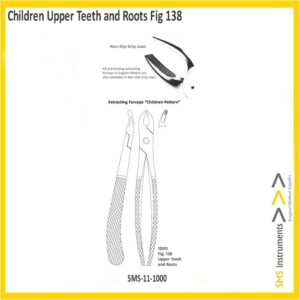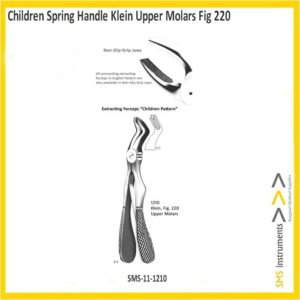Description
Extracting Forceps Children Pattern Lower Molars Fig. 22 S
Dental Instruments
Additional Information
| Surname | Extracting Children Pattern |
| Upper / Lower | Lower |
| Size / Model / Figure | No. 22 S |
| Handle | Plier Forceps |
| Working Surface | Cross Serrated Non-Slip Grip jaws |
| Finishing | Mirror Polish Finishing |
| Instrument Type | Extraction Forceps |
| Material | Stainless Steel |
| Disposable or Reusable | Reusable |
| Rusting Prevention | Passivation Processed |
| Cleaning | Ultrasonic Cleaned |
| Sterile or Non-Sterile | Non-Sterile |
| Latex or Latex-Free | Latex-Free |
| Test Performed | Boil, Shape & Performance Test |
| Grade | Premium OR-Grade |
| Packing | Individually Packed in SMS Brand printed Poly-sleev |
EXTRACTION FORCEPS INFORMATION
Extracting Forceps Children Pattern Lower Molars Fig. 22 S are specialized dental instruments vital for tooth removal procedures, designed to safely extract teeth with both crown and root intact. Unlike general forceps, which are more broadly used for tissue retraction, suturing, and securely holding objects, extraction forceps are hinged and tailored specifically for tooth extraction.
The design of Extracting Forceps Children Pattern Lower Molars Fig. 22 S varies based on factors like the shape, size, and alignment of the roots, as well as the tooth’s location within the mouth. These variations enable dentists to choose the most appropriate tool, ensuring efficient, safe, and precise extractions tailored to each patient’s unique dental anatomy.
Key components of Children Pattern Lower Molars Fig. 22 S include the beaks, which are the part that grips the tooth during extraction. The beaks’ angles and notches are carefully designed to improve grip and match the contour of different teeth. The forceps are typically marked with numbers that identify their specific use, helping practitioners select the correct instrument for each tooth type and position. These numbers correspond to specific forceps styles, which may be designed for upper or lower teeth, left or right positions, or even particular types of teeth like molars or incisors.
Children Pattern Lower Molars Fig. 22 S adhere to general design principles but come in various forms to meet specific needs in dental practices. Their specialized design supports safe, effective extractions, contributing significantly to patient comfort and procedural success.









